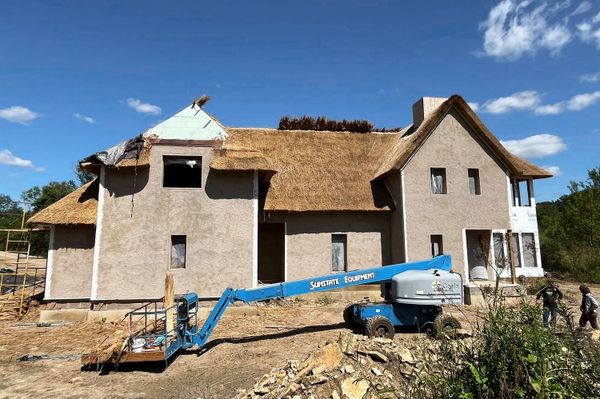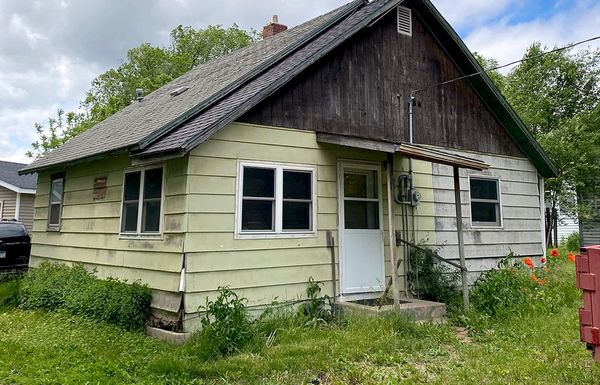The tribe has established a farm, a factory, and construction system to build new houses and revitalize old ones.
In the Cansayapi community in southwest Minnesota, where Danny Desjarlais grew up amid the bluffs and banks of the Minnesota River valley, housing remains a persistent weight on the tribe. The federally funded housing stock that the 40-year-old construction manager grew up in and around hasn’t changed with the times. Many homes are mold-ridden, some need to be torn down, and the pace of replacements and renovations, often just a handful of homes a year, isn’t at all fast enough to provide the housing his tribe needs.
“Most of the homes we have on the reservation are really cheaply constructed,” says Desjarlais, one of the members of the Lower Sioux tribe that call the reservation home. “They are a roof over your head, but the people living here have to decide if they are going to pay for groceries or pay for heating in the winter.”
Desjarlais and other tribal members are working on a way to build homes that’s partially provided by their ancestral homeland itself. The tribe recently announced plans to build 200 new homes with tribal labor and locally grown hemp, which will be processed into sustainable, energy-efficient hempcrete wall panels in a factory the tribe opened last September. A $5 million EPA grant the tribe received in January will also allow them to renovate 30 homes with hempcrete panels, an effort that the Lower Sioux have nicknamed “seed to sovereignty.”
“Traditionally, we were seminomadic and followed the buffalo herds, and used every part of the animal,” says Desjarlais, who is the tribe’s hemp construction manager. “With hempcrete, we’re using every part of the plant, and are going back to more of our natural ways.”

The Lower Sioux held a grand opening of their hemp campus last year, letting visitors look up close at the growing fields.
Photo by Danny Desjarlais

Some hemp homes, like this one, are built using a spray system. Others start with prefabricated hempcrete panels.
Photo by Danny Desjarlais
This kind of renovation and rebuilding—the Lower Sioux initiative has been listed as a finalist for the 2025 Ivory Prize in housing innovation—is indicative of both the long-standing challenges faced by tribal housing, and the contemporary push by Native American tribes to tackle longtime challenges around outdated supply, subpar funding, and sustainability issues. A 2023 Treasury report on tribal housing found that poor federal investment was causing affordable Native American housing to erode; at the same time, the Native American population was growing at twice the rate of the overall U.S. population.
The economics of the hemp housing push make it a cash crop for the tribe. Households typically spend up to $5,000 a year paying for propane to run old heaters in their homes, Desjarlais guesses, but it’s estimated that refurbished and new hemp structures will achieve 70 percent energy savings. Because the hempcrete the tribe is producing is biodegradable, when these new homes need replacing, the structures can be composted.
The long-term structural issues with the existing homes go far back into the long-running U.S. government’s engagement with Native American tribes, says architect Joseph Kunkel, a principal at MASS Design Group and member of the Northern Cheyenne tribe who gives lectures on the history of tribal housing, in addition to helping design new tribal housing and community centers. Kunkel brings up two legal pillars: the 1887 Dawes Act, which placed tribes on reservations and broke up collective land ownership in favor of individual plots and homes; and the 1937 Housing Act, which turned the federal government into a developer of Indian housing, leading to broken community structures and generations of subpar, flimsy, and expensive-to-operate homes.
It wasn’t until the 1996 Native American Housing Assistance and Self Determination Act of 1996, or NAHASDA, which provided more tribal control over housing resources, funding, and construction, that tribes were able to better control federal resources, and with it, their own destiny. While the legislation gave tribes more control of funds via the Indian Housing Block Grant programs, Kunkel says, it didn’t give them experience with architecture, construction, and development, and was “a drop in the bucket” when it came to upgrading older facilities. Nearly one-fifth of tribal housing is manufactured housing, often subpar spaces with heating and cooling challenges.
Kunkel estimates the roughly $1.1 billion dollars in annual federal block grants spread between 574 federally recognized tribes adds up to about eight houses a year per tribe, when many have waiting lists for updated homes that stretch into the thousands.
Renovating can be tricky in these situations, says Kunkel, because often the homes built 30 or 40 years ago aren’t worth rehabbing due to the poor conditions; the assessment work he does for tribes often zeroes in on when it’s worth updating, and when it’s better to start from scratch and start building up a foundation of affordable, energy-efficient tribal housing that can last for the long term.

A late-1800s home was suffering from neglect.
Photo by Danny Desjarlais
See the full story on Dwell.com: How the Lower Sioux Is Harnessing Hemp to Build Sustainable Homes on Its Own Terms
Related stories:



